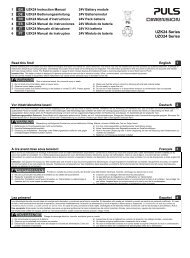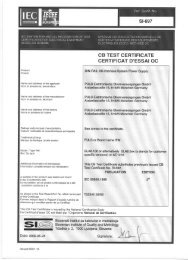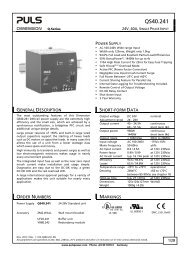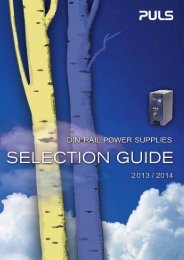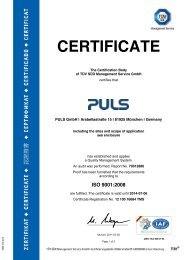PRODUCT SELECTION & PRICING GUIDE
PRODUCT SELECTION & PRICING GUIDE
PRODUCT SELECTION & PRICING GUIDE
You also want an ePaper? Increase the reach of your titles
YUMPU automatically turns print PDFs into web optimized ePapers that Google loves.
Parallel & Series Connections<br />
Paralleling to Increase Output Power<br />
Paralleling allows flexibility and modularity to many<br />
applications. This approach allows readily available<br />
solutions using standard stock items without the<br />
need of looking for a custom model. Paralleling also<br />
allows future expansion without the need of replacing<br />
the original unit. Information as to which units can be<br />
paralleled for increased power can be found in this<br />
Selection Guide.<br />
Power Supply A<br />
AC<br />
Power Supply B<br />
AC<br />
DC<br />
DC<br />
Parallel Connection to Increase the Output Power<br />
+<br />
+<br />
+<br />
Load<br />
Guidelines for Paralleling Supplies<br />
• Only use power supplies in the same family<br />
• Connect as many units in parallel as needed<br />
• A fuse, breaker or redundancy module on the<br />
output is only required if more than three units<br />
are connected in parallel<br />
• Adjust the output voltage of each supply to the<br />
same level<br />
• Keep a side clearance between supplies of at<br />
least 15mm<br />
• Do not mount power supplies above each other<br />
• Use standard mounting orientation<br />
• Leakage current, EMI, inrush current and<br />
harmonics will increase when connecting units<br />
in parallel<br />
Series Connection to Increase Output Voltage<br />
As with paralleling, a series connection allows<br />
flexibility and modularity to many applications. This<br />
approach allows readily available solutions using<br />
standard stock items without the need of looking for<br />
a custom model with a unique output voltage. Many<br />
PULS power supplies can be connected in series to<br />
increase the output voltage. Please check the data<br />
sheet to confirm which units can be put in series.<br />
Guidelines for Series Connections<br />
• Only use identical power supplies<br />
• Connect as many units in series as needed, as<br />
long as the output voltage does not exceed 150VDC<br />
• Voltages with a potential above 60VDC are no<br />
longer SELV and can be hazardous. Install suitable<br />
protection for accidental contact<br />
Power Supply A<br />
AC +<br />
DC<br />
Power Supply B<br />
AC<br />
+<br />
DC<br />
+<br />
Load<br />
• Grounding of the output is required when the sum<br />
of the output voltage is above 60VDC<br />
• Avoid return voltages such as from decelerating<br />
motors or batteries from being applied to the<br />
output terminals<br />
• Keep a side clearance between supplies of at<br />
least 15mm<br />
• Do not mount power supplies above each other<br />
• Use standard mounting orientation<br />
Series Connection to Increase the Output Voltage<br />
• Leakage current, EMI, inrush current and harmonics<br />
will increase when connecting units in series<br />
21




